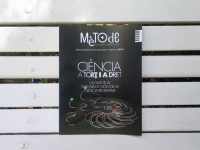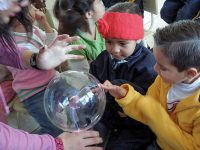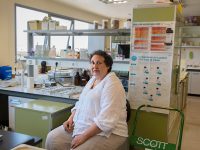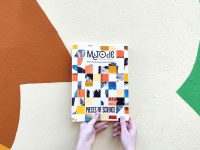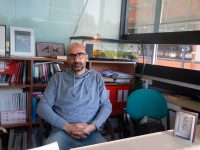
|
|
||
| The year is coming to an end and, with the aim of looking back on scientific progress, we have contacted members of Mètode‘s advisory board to get their opinion on what they consider the most important scientific events within their research fields this year. According to them, 2014 has been marked by the challenge to one of the taboos of science; for the first time in history a woman has been awarded with the Fields Medal, the Nobel Prize equivalent for mathematics. Science in the plant world has provided several advances, including the discovery of the genetic selection processes that made it possible for tomatoes to increase their size a hundred times compared to ancient wild fruits. A part of the molecular and cell mechanisms the plant activates to detect available nitrogen in the soil for its nourishment has also been unfolded. It has also been a good year for discoveries in biology; a new metabolic pathway in a widely studied bacterium- E. Coli- has been found. Other scientific and medical milestone that marked 2014 was the Ebola virus pandemic, which has left Africa for the first time and has boosted its research internationally. | «2014 has been marked by the challenge to one of the taboos of science» | |
 Agencia SINC Agencia SINCMaryam Mirzakhan, first woman to receive the Fields Medal. |
||
|
Fields Medal in Mathematics For the first time in history a woman has won the Fields Medal, an international award for outstanding discoveries in the field of mathematics. It is a distinction granted by the International Mathematical Union (IMU) every four years and is awarded to up to four mathematicians under forty years of age. The Iranian Maryam Mirzakhan, professor at Stanford University in the US, 37, has received what is considered to be the Nobel Prize of these sciences, for her contributions to the geometry and dynamics of Riemann surfaces and their moduli spaces. According to Olga Gil Medrano, professor of mathematics at the University of Valencia «with this award, the IMU marks a historic milestone because it is the first time -after nearly eighty years of existence- that a Fields Medal honours the work of a woman». |
«For the first time in history a woman has won the Fields Medal, an international award for outstanding discoveries in the field of mathematics» |
|
 Agencia SINC Agencia SINC |
||
|
Plant molecular and cell biology Jose Pío Beltran, CSIC research professor at the Institute for Plant Molecular and Cell Biology, highlights a contribution in what he calls «new biology». An international committee has studied genome sequences in 360 different tomato varieties and has unravelled important processes that have happened during the domestication of tomatoes. It was possible to detect genetic selection processes that have enabled tomato fruits to grow a hundred times larger regarding the ancestral wild fruit. The study, published on Nature, describes the achievements as well as the costs of this historical selection and provides a molecular view focused on further improvements. Another study published by Science has made a very important contribution to plant physiology, revealing that plants are capable of leading the development and direction of their roots to find nitrogen in the soil. Nitrogen is an essential nutrient for plants, but it is often unevenly distributed in the ground. The authors of this research describe the nature of the signal that roots send to the stem to warn about the deficit of nitrogen in the plant. Molecular systems that help nitrogen perception have also been studied as well as the long distance sign emission needed to alter root development. This signal helps the plant to adjust to fluctuations in the availability of nitrogen. Bacteria and metabolic pathways In terms of biology, Juli Peretó, professor at the Cavanilles Institute for Biodiversity and Evolutionary Biology, University of Valencia, highlights the discovery of a new metabolic pathway in Escherichia coli: sulpho-glycolysis. This bacterium is, according Peretó, «probably the one that is most used by researchers in biochemistry and molecular biology and many details regarding its physiology are known.» However, «it is surprising that years after the publication of its complete genome, someone can still describe a metabolic process that was completely unknown until now.» A process that takes place in these bacteria and which has great relevance in sulphur recycling in the biosphere has also been unravelled. Its authors have identified the genes responsible for the process and have described in detail all its biochemical transformation from Sulfoquinovose (a sulfurised sugar produced by plants at 10,000 million tons a year) to final products incorporated to metabolism, as well as sulphate, which is transferred to the environment, explains Professor Peretó. According to the biochemist this is a great example to illustrate that «although we know many things about how cells work, there are still fundamental processes we do not know about». «Discovering a new metabolic pathway in bacteria such as E. coli is in itself a sample of the limits of our biochemical knowledge». |
«Jose Pío Beltran highlights a contribution in what he calls “new biology” » |
|
 Agencia SINC Agencia SINCVirtual representation of the Ebola virus. |
||
|
Science or techno-science? Josep Lluís Barona, professor of History of Science at the López Piñero Institute, University of Valencia, believes that today science, or «techno-science» as he really perceives it, «does not evolve from great discoveries or heroes, rather, it faces serious problems step by step or provides new knowledge that improves human life ». Science now walks «into knowledge economy, bringing innovations with practical applications to solve problems and prospects of social and economic impact» Barona argues. As an example of this he uses the last three Nobel prizes in physics, chemistry and medicine, which «bring no theoretical contribution, but have a practical application: LED lights; nanoscopy or fluorescent microscopy, used to detect molecules within cells; and the description of brain cells associated with the sense of orientation». «Research is oriented towards the solution of practical issues, not conceptual problems (knowledge) and profits (through patents).» Professor Barona considers a problem the little theoretical direction modern science takes, in the sense that it changes little or nothing major existing paradigms and thinks «it is at the service of certain ideas of progress, which are embedded in our socioeconomic system». Within this framework Barona indicates that one of the great scientific issues of the year was the Ebola pandemic, which «has questioned existing ideas on the current epidemiology and therefore marked a turning point in the international fight against infectious diseases». According to WHO reports there have been 19,497 confirmed Ebola cases and 7,588 deaths since the start of the pandemic. This virus appeared in the 1970s and until now it had only affected Africa. This year, the US has confirmed four cases, and our country one: Teresa Romero’s, a nurse who was infected while treating a patient, a missionary who had been repatriated. 2014 ends with new questions for science in the field of biochemistry and the overcoming of sexist taboos in the field of mathematics and gives way to a new year for medical research to find a vaccine to fight the Ebola virus, which had not challenged first world countries until now. There is still much to discover and the limits of our knowledge have been highlighted by recent scientific studies. Teresa Coll. Student of Journalism at the University of Valencia. |
«The year ends with new questions for science in the field of biochemistry» |
|


